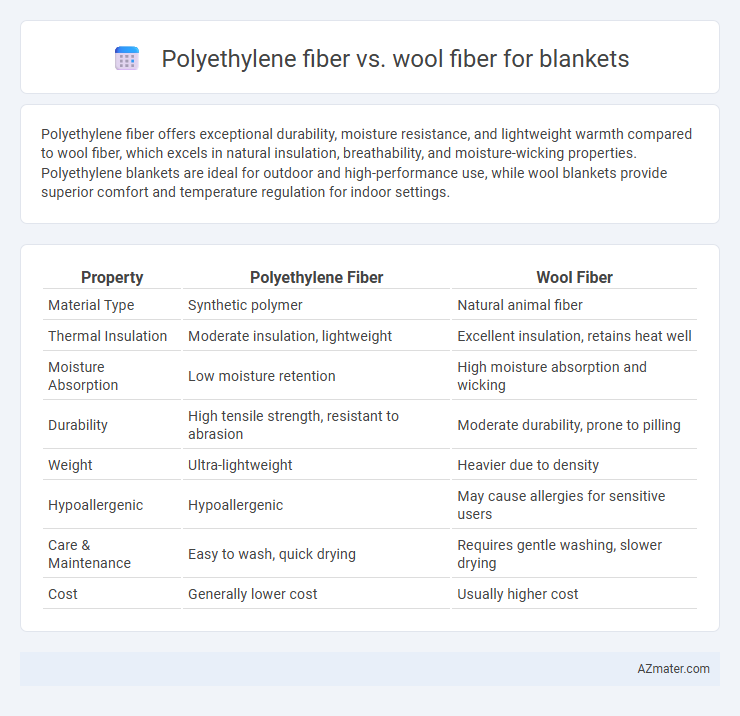Polyethylene fiber offers exceptional durability, moisture resistance, and lightweight warmth compared to wool fiber, which excels in natural insulation, breathability, and moisture-wicking properties. Polyethylene blankets are ideal for outdoor and high-performance use, while wool blankets provide superior comfort and temperature regulation for indoor settings.
Table of Comparison
| Property | Polyethylene Fiber | Wool Fiber |
|---|---|---|
| Material Type | Synthetic polymer | Natural animal fiber |
| Thermal Insulation | Moderate insulation, lightweight | Excellent insulation, retains heat well |
| Moisture Absorption | Low moisture retention | High moisture absorption and wicking |
| Durability | High tensile strength, resistant to abrasion | Moderate durability, prone to pilling |
| Weight | Ultra-lightweight | Heavier due to density |
| Hypoallergenic | Hypoallergenic | May cause allergies for sensitive users |
| Care & Maintenance | Easy to wash, quick drying | Requires gentle washing, slower drying |
| Cost | Generally lower cost | Usually higher cost |
Introduction to Polyethylene and Wool Fibers
Polyethylene fiber, a synthetic polymer known for its high strength-to-weight ratio, is lightweight, durable, and resistant to moisture and chemicals, making it ideal for modern blanket manufacturing. Wool fiber, derived from sheep, provides natural warmth, breathability, moisture-wicking properties, and excellent insulation due to its crimped texture and lanolin content. While polyethylene offers easy maintenance and long-lasting use, wool fibers deliver superior comfort and thermal regulation in blankets.
Fiber Structure and Composition
Polyethylene fiber features long, linear polymer chains with high crystallinity, resulting in a smooth, hydrophobic surface that enhances moisture resistance and durability for blankets. Wool fiber consists of complex protein structures with keratin-based, scaly cuticles, providing natural insulation, breathability, and moisture-wicking properties. The synthetic composition of polyethylene offers superior tensile strength and quick-drying capabilities, while wool's natural fiber structure excels in temperature regulation and softness.
Warmth and Insulation Properties
Polyethylene fiber offers exceptional moisture-wicking and thermal insulation, making blankets highly effective at retaining warmth in damp conditions. Wool fiber naturally regulates temperature through its breathable, crimped structure, providing superior insulation by trapping air and maintaining heat even if the fiber becomes slightly wet. Comparing warmth and insulation, wool blankets excel in natural heat retention and moisture management, while polyethylene blankets deliver consistent thermal performance with enhanced water resistance.
Softness and Comfort Comparison
Polyethylene fiber blankets offer a smooth, lightweight texture that is water-resistant and durable, but they generally lack the natural softness and breathability found in wool fibers. Wool fibers provide exceptional softness, warmth, and moisture-wicking properties, enhancing overall comfort by regulating body temperature and reducing itchiness. For those prioritizing ultimate comfort and a plush feel, wool is superior, while polyethylene fibers excel in durability and easy maintenance.
Breathability and Moisture Management
Polyethylene fiber offers excellent moisture-wicking capabilities, rapidly drawing sweat away from the skin to keep the blanket dry and comfortable during use. Wool fiber, known for its natural breathability and moisture absorption, can absorb up to 30% of its weight in moisture while still feeling dry, enhancing thermal regulation. While polyethylene excels in quick-drying properties, wool provides superior insulation and moisture retention, making each fiber suitable for different blanket performance needs.
Durability and Longevity of Blankets
Polyethylene fiber blankets offer exceptional durability and resistance to abrasion, making them highly suitable for long-term use in high-traffic or outdoor environments. Wool fiber blankets provide natural resilience and elasticity, which contributes to their ability to maintain shape and warmth over extended periods. While wool excels in moisture-wicking and thermal regulation, polyethylene blankets outperform in terms of resistance to tearing and color fading, enhancing their longevity.
Hypoallergenic and Skin Sensitivity Aspects
Polyethylene fiber is hypoallergenic and resists dust mites, making it ideal for individuals with sensitive skin or allergies, whereas wool fiber can sometimes cause irritation or allergic reactions due to lanolin and its coarse texture. Polyethylene's synthetic properties prevent moisture buildup, reducing the risk of skin irritation often experienced with natural fibers like wool, which may retain sweat and promote bacterial growth. For those prioritizing skin sensitivity and allergy prevention, polyethylene fiber offers a more suitable, non-irritating option compared to traditional wool blankets.
Environmental Impact and Sustainability
Polyethylene fiber blankets offer durability and water resistance but are derived from non-renewable petroleum resources, contributing to microplastic pollution and a larger carbon footprint compared to natural fibers. Wool fiber blankets come from a renewable resource with natural biodegradability, providing excellent insulation while promoting soil health through sustainable grazing practices. Choosing wool blankets supports carbon sequestration and reduces reliance on synthetic materials, aligning better with environmental sustainability goals.
Care, Maintenance, and Cleaning
Polyethylene fiber blankets require minimal care due to their resistance to moisture, stains, and mildew, making them easy to clean with simple machine washing and quick drying. Wool fiber blankets need gentle handling, usually hand washing or dry cleaning, to prevent shrinkage and maintain fiber integrity, and require drying flat away from direct heat to avoid damage. Regular maintenance of wool blankets includes brushing to remove dirt and airing out to reduce odors, while polyethylene fibers offer superior durability and resistance to frequent washing.
Cost and Accessibility
Polyethylene fiber blankets generally cost less than wool fiber blankets due to cheaper raw materials and more scalable manufacturing processes. Polyethylene fibers are widely accessible in synthetic textile markets, offering affordable options for mass production. Wool fiber, while pricier, is less accessible in regions without sheep farming, making it a premium choice for high-quality blankets.

Infographic: Polyethylene fiber vs Wool fiber for Blanket
 azmater.com
azmater.com